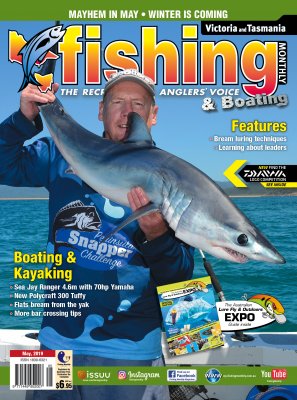Luring techniques for bream by Jarrod Day
 Would you believe it if I said that Victoria has more than 100 estuaries spanning from South Australia to the New South Wales border? It's true, and over 90% of them are fish rich, with the most popular species being the black bream.
Would you believe it if I said that Victoria has more than 100 estuaries spanning from South Australia to the New South Wales border? It's true, and over 90% of them are fish rich, with the most popular species being the black bream.
Anglers seeking bream are familiar with the most popular estuaries from the West Coast to the East Coast, the Hopkins River, Werribee River, Maribyrnong River, Yarra River, Patterson River and of course the entire Gippsland system. Still there are plenty of other smaller creeks and rivers all worth exploring right along the coastline.
For their size, bream certainly are a lot of fun to catch and while they will seek out a soaked bait, they are also willing lure takers making them an avid sportfish for anglers looking to lock horns using light tackle.
On any given day of the week there isn't an estuary around the state that doesn't have someone sitting back in their chair or perched upon a fishing platform flicking a lure or soaking a bait in hope of catching a bream. But it isn't until you catch your first bream using a lure that you'll become infatuated with the species.
STRUCTURE
Bream are like that inquisitive little kid in school when you were young. One minute they are all nice and playful and within the blink of an eye, turn into a nasty little devil that you just can't get within reach to teach a lesson.
They say that fish have a three second memory, but I think bream have somehow evolved and know every angler's weakness. They also know every single piece of timber, rock, weed and boat hull in an estuary to bust you off on.
Bream love structure and they certainly use this to their advantage. Whether it's a submerged log, jetty pylon, rock wall or boat hull, bream use these structures for somewhere to hide. Structure also provides bream with a food source, be that a cultivation of mussels or a school of baitfish also seeking shelter. Either way, if you want to catch bream, you must fish around structure.
In saying that, there are exceptions to this rule, which tends to be more focused in the winter months or after heavy rain. During these periods, bream will move away from the structure and school up in the main bodies of water. This is particularly noticeable just before spawning (August-January) when they congregate before making their way up the estuaries to spawn.
LURE SELECTION
Due to the nature of bream and their wary characteristics, you really do have to play their game and to do this it is imperative you find out what they want. Of course, there are always your typical 'go-to' lures, but if they don't work at a certain time of the year, you need a backup. It pays to be versatile and carry a wide array of lures for any situation and if you are just starting out on the bream scene, it may take a while to build your collection.
Bream can be targeted using a variety of lures and each is used depending on where and how the fish are feeding.
If you're cruising along the flats of an estuary and see them feeding on the sand, then you'll want to be flicking a shallow diving hardbody or surface lure. Then again, they might be grinding mussels off the pylons where a slow sinking soft plastic would be what they want.
A typical bream tackle kit might consist of a half dozen surface lures, shallow cranks, deep cranks, deep minnows, various soft plastics and some sinking stickbaits.